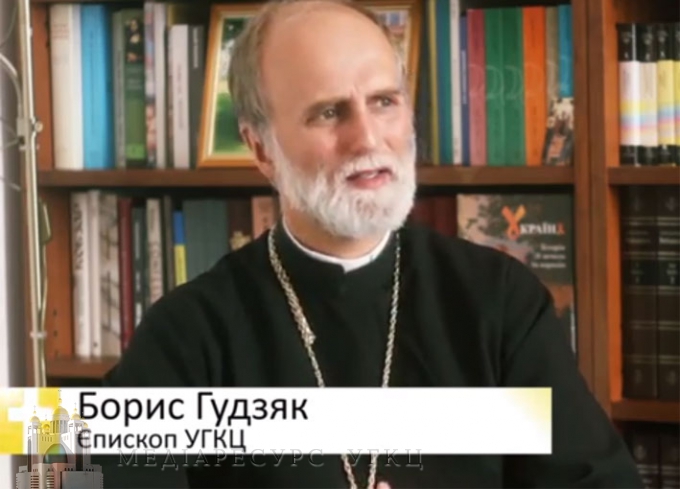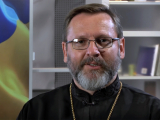Cathedral of the Resurrection of Christ as a means of communication in our Church
Friday, 06 September 2013, 10:32 We are nearing the International all-Church Pilgrimage to the Patriarchal Cathedral of the Resurrection of Christ in Kyiv on the occasion of the 1025th anniversary of the Baptism of Rus-Ukraine during which Patriarch Sviatoslav together with the Synod of Bishops of our Church, accompanied by all the prayers of the people, will consecrate the cathedral altar.
-
See also:
- His Beatitude Sviatoslav congratulated Metropolitan Borus Gudziak on the 10th anniversary of his episcopal consecration
- No event has ever been as extensively covered in the global consciousness as the war against Ukraine, - UGCC Metropolitan Borys Gudziak
- God’s truth will prevail: How the Ukrainian Catholic Metropolia of Philadelphia helps Ukrainians during the war?
The time of the blessing is symbolic because it will be then that the pilgrims from the whole world will assemble in Kyiv, and among them will be our bishops who gathered here for the Synod of Bishops. Guests from Eastern Catholic Churches of Europe and the heads of the Conferences of Bishops of the Roman Catholic Church from various countries are expected.
It is very important to partake in this celebration of our people and the Church on the banks of the Dnipro River, to personally feel God’s glory, which was prophesized by Apostle Andriy, to experience in a new way the sacrament of Volodymyr’s Baptism and to contemplate the testimony of the martyrs and confessors of our Church.
It is also important to unite in contemplation and prayer as to the symbolism of the concept and adornment of the Cathedral. I know that in art circles there are related discussions going on regarding this topic. Permit me to share a few thoughts about the completion of our main cathedral.
I note immediately that the discussion is not about a simple “ornament” or “decoration” of this monumental church. The adorned Cathedral has to universally proclaim the truth about God and man – authoritatively (not authoritarianly), broadly, comprehensively, beautifully, impressibly.
The Cathedral has to talk, to communicate. To do this, one must know precisely what is being said,
to whom and how. In a simple scheme of communication which is used in the media: information, audience, channel.
“What?” Our information is determined through the Tradition, that is, through live teachings, through the very life of the Church. It is already determined but also it is continuously being determined: the teachings and the life of the Church develop, gain new accents, a new fullness and simultaneously correct the worn-out, incomprehensible or erroneous articulations. Therefore, the Second Vatican Council, the history of the martyrdom and the confessors of Ukrainian Christianity, the ecumenical imperative, the current global awareness as to the variety of world cultures—these all should be imbedded in the lexicon, style, art language of the new Cathedral.
“To whom? For whom?” It seems obvious, yet with some deeper contemplation it is far from being simple. Any marketing agent proposing a new product first teaches his audience. Let us contemplate in prayer on the condition of today’s man, today’s believer. Who is our believer today? Who goes to church? What hurts or perturbs her/him? Who is today’s resident of the multi-million city of Kyiv? Who does the Church aim to convert, to bring back through this Cathedral?
“How?” to communicate the Tradition, the life of the Church to today’s man, the people of the 21st and the coming centuries? What kind of perception is today’s person capable of? To what perception may today’s person be raised? What does today’s person see, hear, feel; how to assist a person to see, hear, feel, in other words, “to live” with the Church and in the Church? For centuries the churches, their architecture, iconography and liturgical acts which took place there formed, changed people’s consciousness and inspired them. So it should be with our Cathedral.
Just as Christ Himself so also the Cathedral of His Resurrection should speak to all. Its embrace should welcome all. This profound symbolic affirmation has a very practical dimension.
First of all, it should be physically available to everyone: infants with parents, families, children, youth, adults, seniors, physically and mentally challenged, blind, deaf. They are an essential part of the sermon about God (and His Church), who stretches his hand to all the needy, about which now constantly Pope Francis so vividly reminds us.
It is very important that the ornaments and furniture of the church do not block the line of vision for a large part of the faithful. One should ensure the appropriate illumination and acoustics. Good acoustics and good illumination even in an average church provide much inspiration and a deep experience. When the light and acoustics do not work, the atmosphere in the church is choked and the experience of the faithful is muffled.
In addition to communicating through vision, hearing, smelling, our Cathedral should also speak through touching. Let us remember how in the Basilica of St. Peter in Rome, all go to touch the foot of the Altar. It is important to pay due attention to the contemporary person’s need for interaction.
Today the best museums know how to strikingly address the spiritual imagination of a person. Our Cathedral has to be a place of especially effective communication of the Tradition. Let us not be afraid to think creatively, radically, steeping ourselves deep into the roots of the issue of communication. Let us remember, that practically all of the clear expressions of communication (involving also the printed one) which have become acceptable first evoked misunderstanding, criticism and rejection. The fabula of our redemption, the modern history of our Church demands from us a creative feat, which is always complicated and often painful -- never simply the completion of a building plan.
The internal finished details of the Cathedral of Christ’s Resurrection should maximally enhance personal prayer as well as communal, liturgical services, the Eucharist, a 24 hour schedule of services, mass prayer, and processions.
The Cathedral should be deeply mystical and evangelizing. It should “speak” and “be understandable.”
The Cathedral should “illustrate, reflect” the Sacrament of the Incarnation of God as Man and the Sacrament of the Church. For example, the person who enters the Cathedral should see a clear invitation to (or remembrance of) Baptism. The Cathedral should be “universal, Kyivan, and resurrected.” These topics should be in the center of prayer and discussion among the creators of the Cathedral.
Our Church, its present and the recent past, is proof that in our days the Lord acts in history. He wins. In early Christianity, for example, in the churches in Ravenna, the cross was paradoxical, a sacred sign of victory, and other symbols (such as the lamb) turned one’s attention to the essence, raised the spiritual vision of the believers (and the non-believers) to the essential. So also in our Cathedral, simple symbols can be especially meaningful to contemporary people who are overburdened with images and content.
It is important to find the current language and to protect oneself from the errors of sacred architecture and art which have happened in the last decades, when unsuccessful attempts at modernism and post-modernism were often connected with abstract (non-liturgical) “ideas” (e.g., “light”, “serenity”, “nature”, etc.) in themselves disconnected from the historical drama of the redemption. The Cathedral should lean not towards individualism but towards nourishing and forming the universality of persons. The theological personification and ecclesiology of a shared communion of people created in the image and likeness of God should characterize the experience of praying in our Cathedral.
Let us remember the post-soviet churches in Moscow, Yerevan, and Tbilisi. These are grand projects although for many people today this grandiosity is not understandable. In such churches it is difficult for some to pray – they are not created for the individualistic person of the 21st century. When Liturgies are held there, these churches get filled with a spirit. However, most of the time when there are no services, there are many visitors and they remind one of museums. Here the lost people come, seeking in all this greatness and splendor, a corner for themselves, for prayer… How is it possible to bring a great tradition close to a real average person? Our Cathedral should simultaneously be grand and yet speak to the soul of each separate person, who being tired of the pavement, tall buildings and noise of the Left Bank will enter the Cathedral in search of silence, prayer, God and oneself.
The goal of an art project lies not only in the results but also through the process which should be maximally a shared creation and transparent. The Cathedral should be created amidst universality, in the interaction of God’s people. So that the members of our Church can name the architect, the icon painter of the Cathedral and be able to explain the architectural, artistic concept, to feel that the church is theirs, that it is composed of bricks, pieces of the soul of every faithful. The Cathedral has to be for centuries, a symbol of faith for the contemporaries, a point of pride for the descendants, a testimony of God’s glory which shone over the Dnipro.
Let us pray for the creators of our Cathedral, the architects, icon painters, donators, clergy and monasticism, the faithful and all Kyiv residents who in the last few years have enlivened our Cathedral in which eventually God Himself will breathe in life and will make it His home. Because if it is not He who is building the home, then it is useless for the builders to work… Useless are the artistic discussions and the fund-raising campaigns, useless are the efforts if in their midst Christ does not stand, whose Cathedral of His Resurrection we will ceremoniously bless in a few days.
Bishop Borys (Gudziak)

We can imagine what the prayer of the prisoners in the Russian torture centers in the Ukrainian Kharkiv region was like – Head of the UGCC on the 206th day of the war 17 September
A vast cemetery, a mass burial, was found near the city of Izyum, in which more than 400 innocently killed and tortured people have already been...

